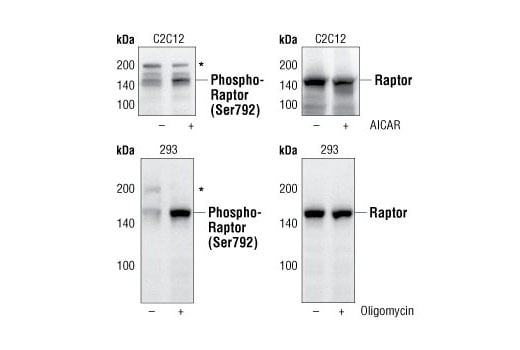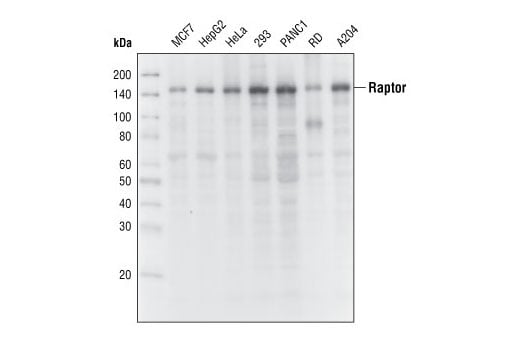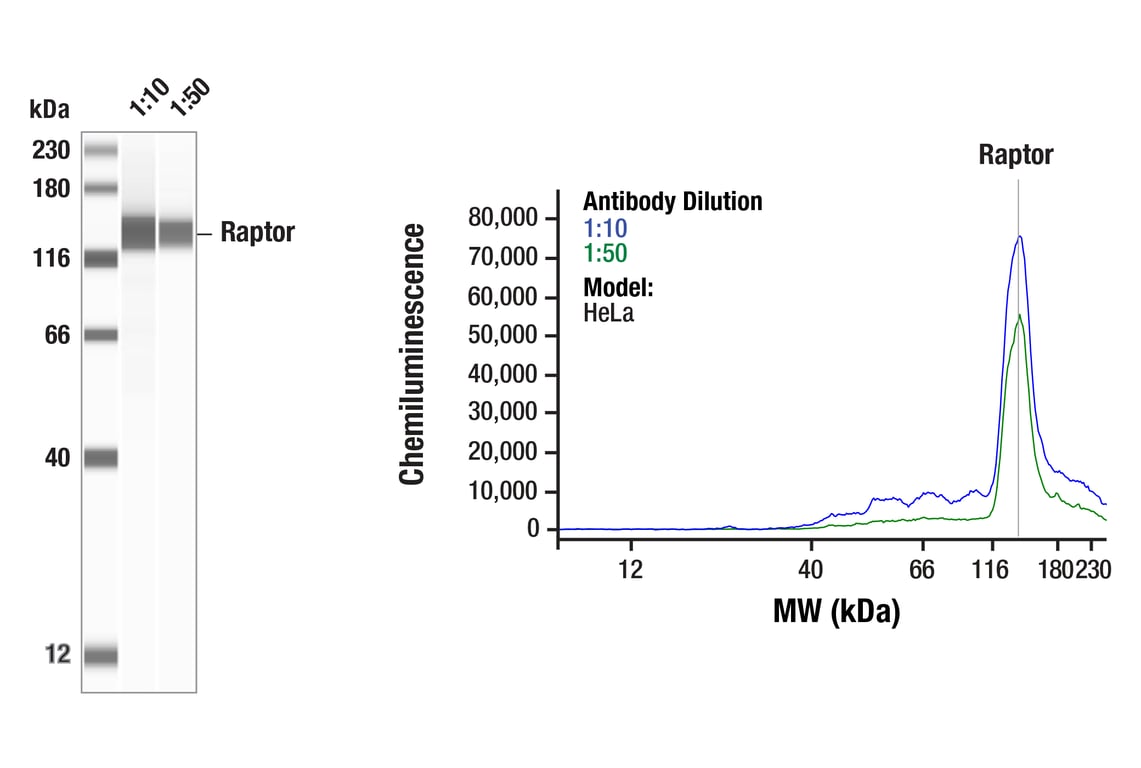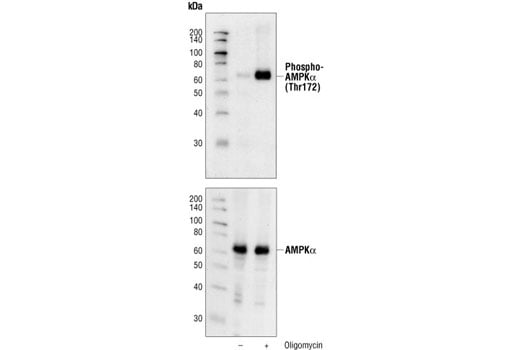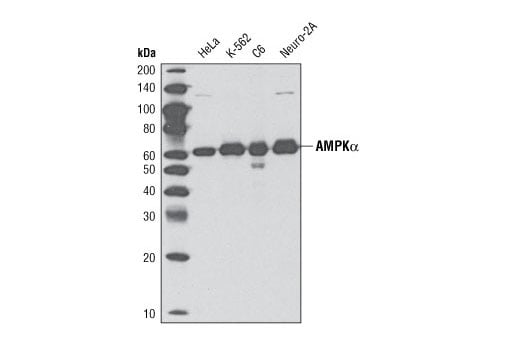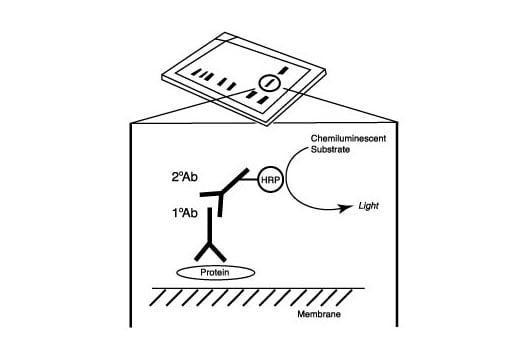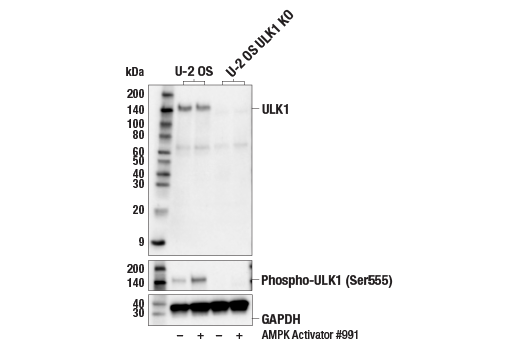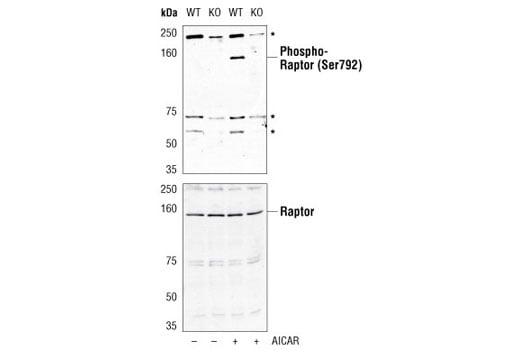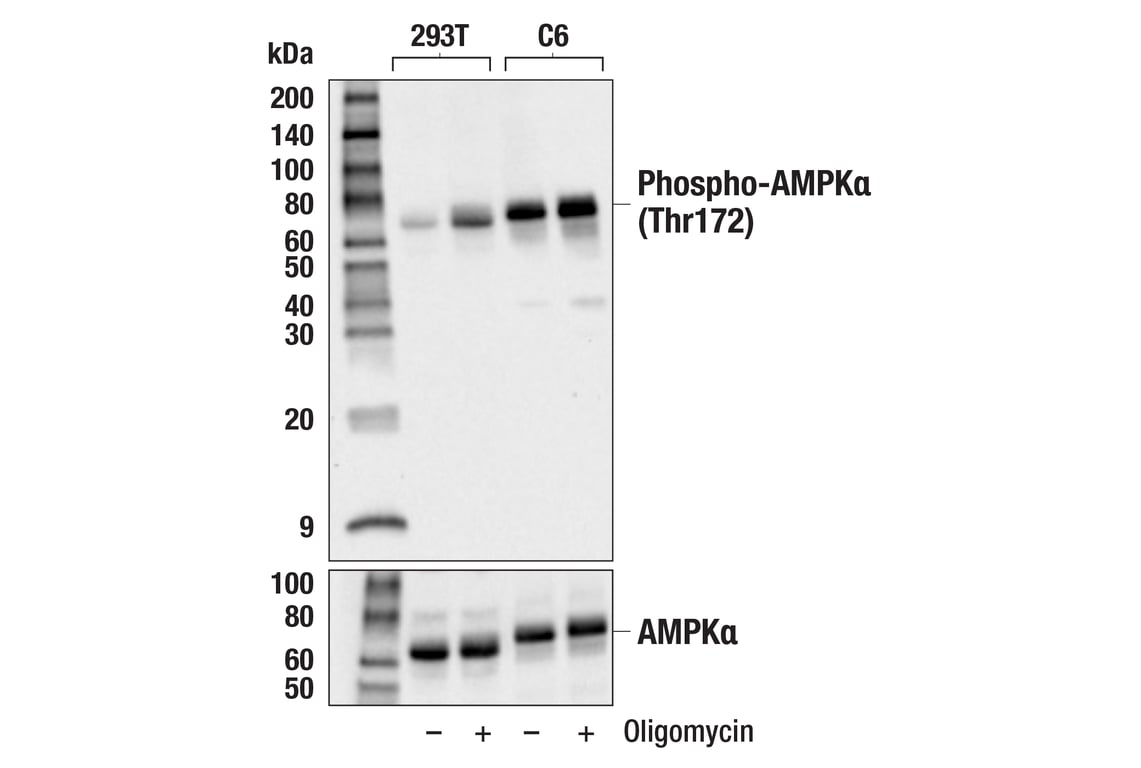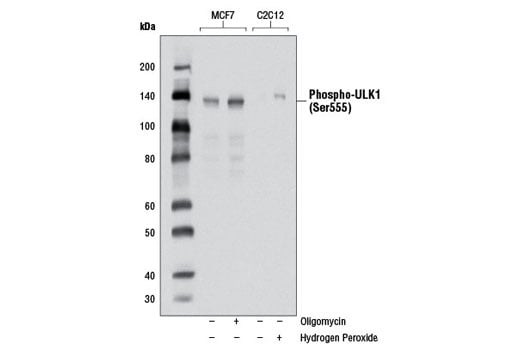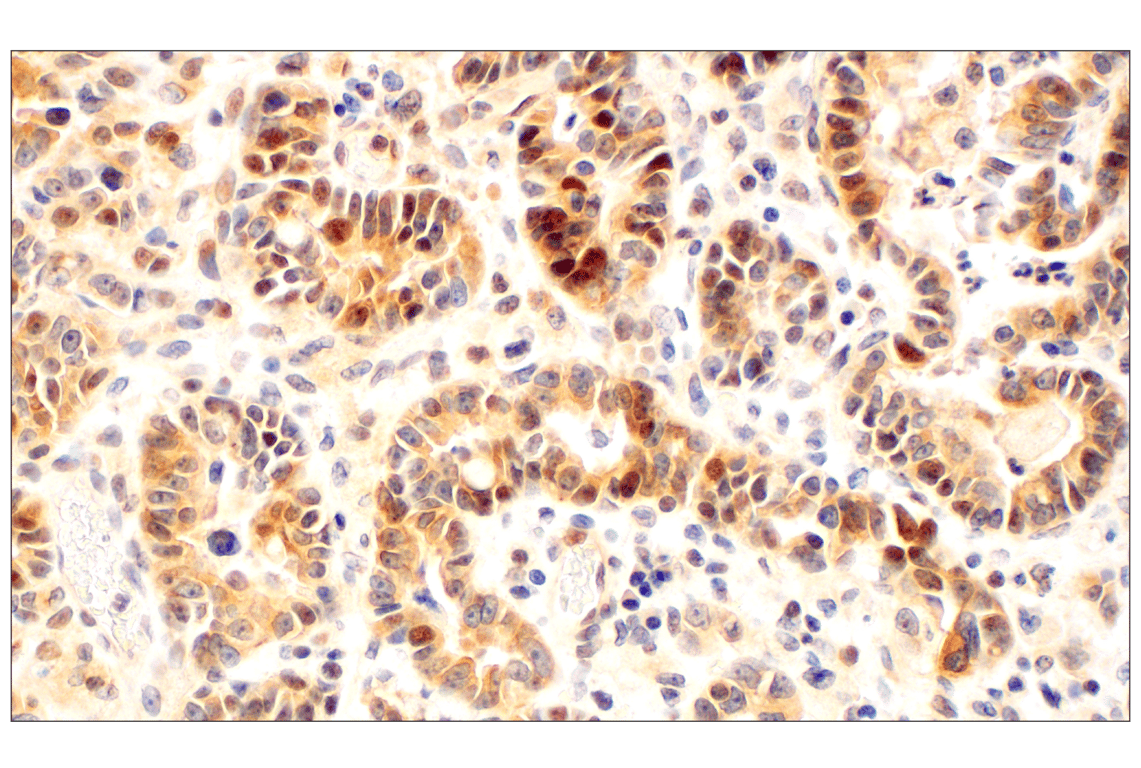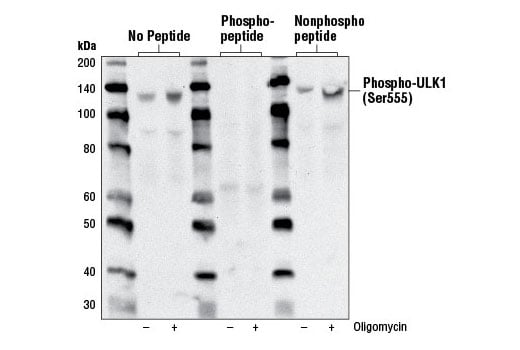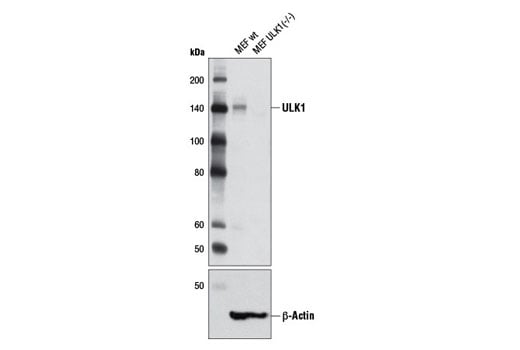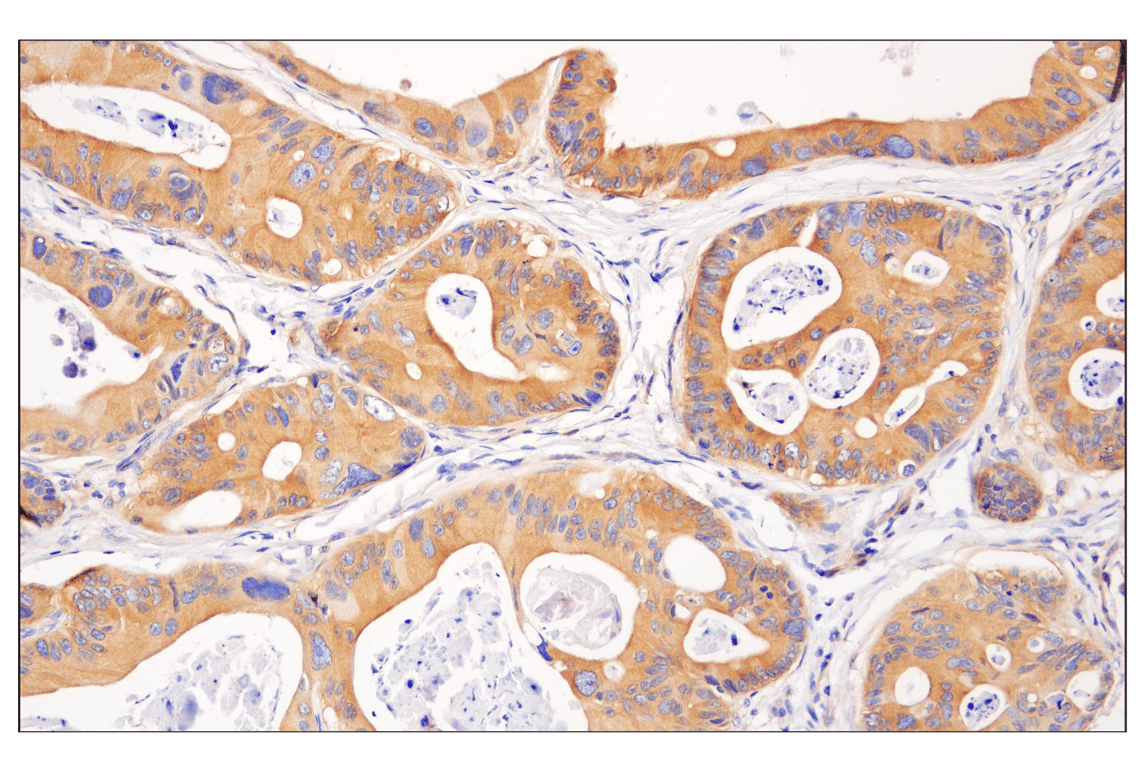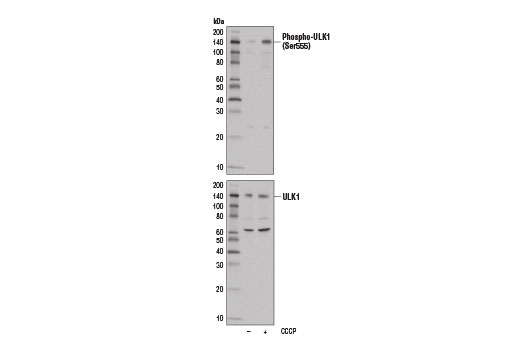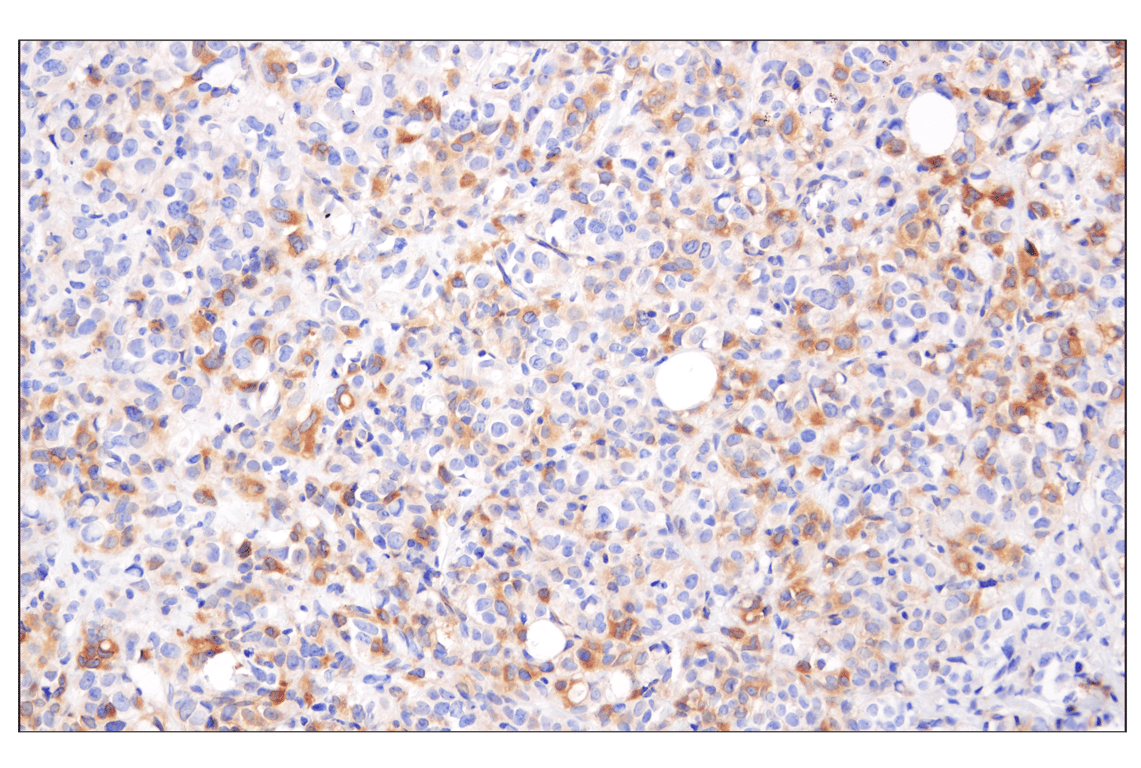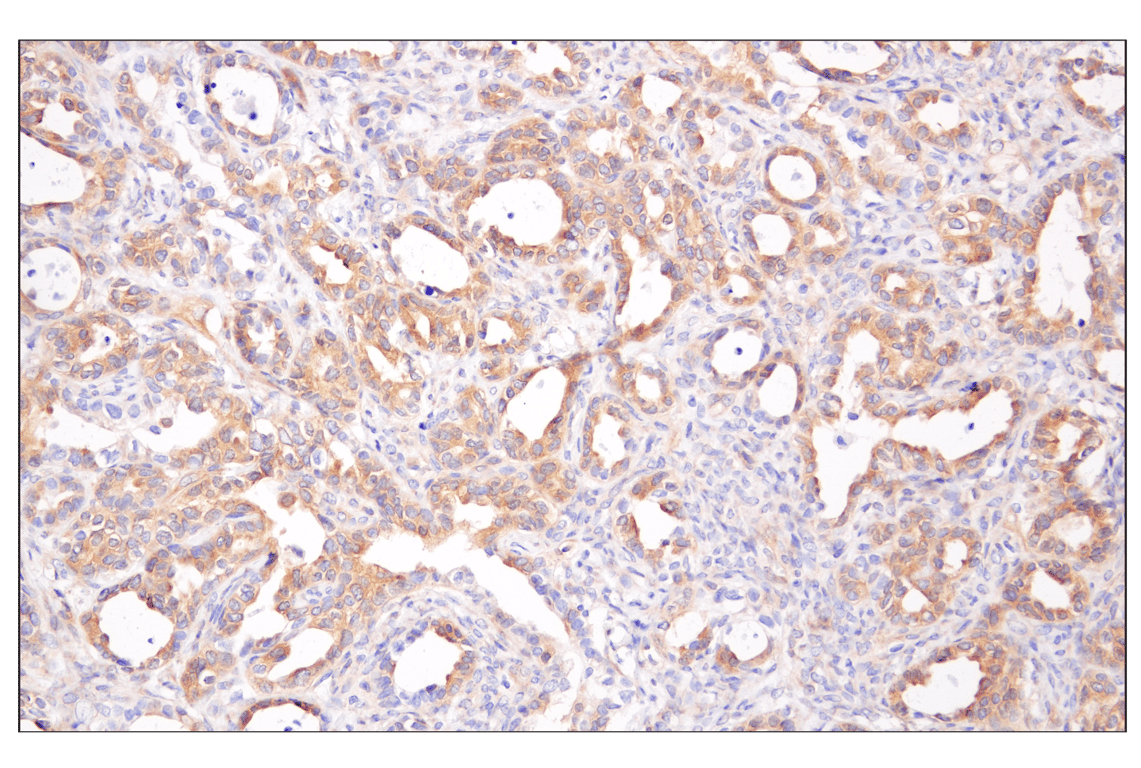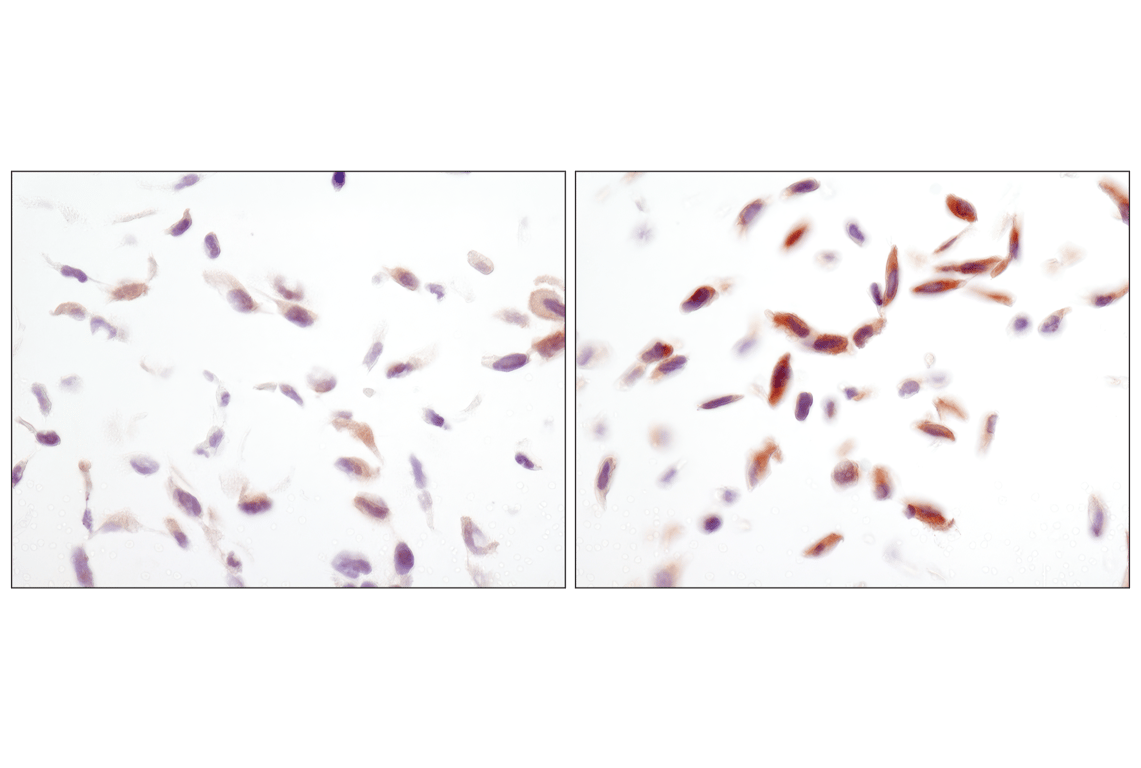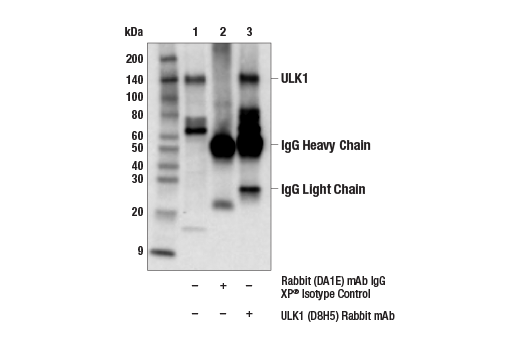 全部商品分类
全部商品分类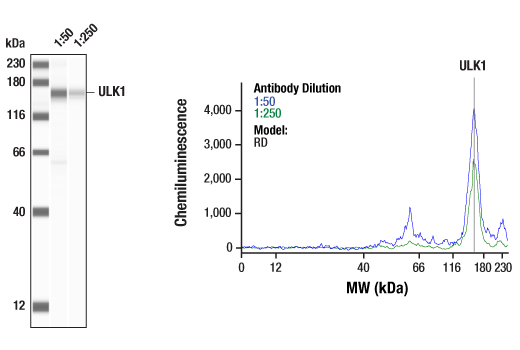



 下载产品说明书
下载产品说明书 下载SDS
下载SDS 用小程序,查商品更便捷
用小程序,查商品更便捷


 收藏
收藏
 对比
对比 咨询
咨询
The ULK1 Antibody Sampler Kit provides an economical way to investigate ULK1 signaling. The kit contains enough primary antibody to perform two western blots with each primary antibody.






参考图片
Simple Western™ analysis of lysates (0.1 mg/mL) from RD cells using ULK1 (D8H5) Rabbit mAb #8054. The virtual lane view (left) shows a single target band (as indicated) at 1:50 and 1:250 dilutions of primary antibody. The corresponding electropherogram view (right) plots chemiluminescence by molecular weight along the capillary at 1:50 (blue line) and 1:250 (green line) dilutions of primary antibody. This experiment was performed under reducing conditions on the Jess™ Simple Western instrument from ProteinSimple, a BioTechne brand, using the 12-230 kDa separation module.
Western blot analysis of C2C12 or 293 cells, untreated or treated with AICAR (0.5 mM for 30 minutes) or oligomycin (0.5 μM for 30 minutes), using Phospho-Raptor (Ser792) Antibody (upper and lower left ) or Raptor Antibody #2280 (upper and lower right).*Cross-reacting bands at 200 kDa.
Western blot analysis of extracts from various cell lines, using Raptor (24C12) Rabbit mAb.
Simple WesternTM analysis of lysates (1 mg/ml) from HeLa cells using Raptor (24C12) Rabbit mAb #2280. The virtual lane view (left) shows the target band (as indicated) at 1:10 and 1:50 dilutions of primary antibody. The corresponding electropherogram view (right) plots chemiluminescence by molecular weight along the capillary at 1:10 (blue line) and 1:50 (green line) dilutions of primary antibody. This experiment was performed under reducing conditions on the JessTM Simple Western instrument from ProteinSimple, a BioTechne brand, using the 12-230kDa.
Western blot analysis of extracts from C2C12 cells, untreated or oligomycin-treated (0.5 µM), using Phospho-AMPKα (Thr172) (40H9) Rabbit mAb (upper) or AMPKα Antibody #2532 (lower).
Western blot analysis of extracts from HeLa, K-562, C6, and Neuro-2a cells using AMPKα (D63G4) Rabbit mAb.
Western blot analysis of extracts from control U-2 OS cells or CRISPR/Cas9 ULK1 knockout (KO) U-2 OS cells, untreated (-) or treated with AMPK Activator 991 (50 μM, 1 hr; +) using Phospho-ULK1 (Ser555) (D1H4) Rabbit mAb (upper), ULK1 (D8H5) Rabbit mAb #8054 (middle), or GAPDH (D16H11) XP® Rabbit mAb #5174 (lower). The absence of signal in ULK1 KO cells confirms the specificity of the antibodies for ULK1. ULK1 knockout cells were kindly provided by Dr. Reuben Shaw, Salk Institute for Biological Studies, La Jolla, CA.
Western blot analysis of extracts from A172 cells, untreated (-), Torin 1-treated (+; 250 nM; 5 hrs), or INK-128-treated (+; 250 nM; 5 hrs) using Phospho-ULK1 (Ser757) Antibody (upper) or total ULK1 (D8H5) Rabbit mAb #8054 (lower).
After the primary antibody is bound to the target protein, a complex with HRP-linked secondary antibody is formed. The LumiGLO® is added and emits light during enzyme catalyzed decomposition.
Western blot analysis of extracts from control U-2 OS cells or CRISPR/Cas9 ULK1 knockout (KO) U-2 OS cells, untreated (-) or treated with AMPK Activator 991 (50 μM, 1 hr; +) using ULK1 (D8H5) Rabbit mAb (upper), Phospho-ULK1 (Ser555) (D1H4) Rabbit mAb #5869 (middle), or GAPDH (D16H11) XP® Rabbit mAb #5174 (lower). The absence of signal in ULK1 KO cells confirms the specificity of the antibodies for ULK1.ULK1 knockout cells were kindly provided by Dr. Reuben Shaw, Salk Institute for Biological Studies, La Jolla, CA.
Western blot analysis of wild-type (WT) and AMPKα1 and α2 knockout (KO) mouse embryonic fibroblasts (MEFs), untreated or treated with AICAR (2 mM for 1 hour), using Phospho-Raptor (Ser792) Antibody (upper) or Raptor Antibody #4978 (lower). (Image provided by Dr. Reuben Shaw, Salk Institute for Biological Studies).*Cross-reacting bands at 60, 70 and 240 kDa
Western blot analysis of extracts from 293T and C6 cells, untreated (-) or treated with Oligomycin (5uM, 30mins; +) using Phospho-AMPKα (Thr172) (40H9) Rabbit mAb (upper) or AMPKα (D5A2) Rabbit mAb #5831 (lower). Phospho-AMPKα (Thr172) is induced by Oligomycin treatment as expected.
Western blot analysis of extracts from MCF7 cells, untreated or treated with oligomycin #9996 (0.5 μM, 30 minutes), and C2C12 cells, untreated or treated with hydrogen peroxide (10 mM, 5 minutes), using Phospho-ULK1 (Ser555) (D1H4) Rabbit mAb.
Western blot analysis of extracts from A-431 cells, untreated or treated with Human Epidermal Growth Factor (hEGF) #8916 (100 ng/ml, 30 min) using Phospho-ULK1 (Ser757) Antibody (upper), or α-Tubulin (11H10) Rabbit mAb #2125 (lower).
Western blot analysis of extracts from various cell lines using ULK1 (D8H5) Rabbit mAb.
Immunohistochemical analysis of paraffin-embedded human esophageal carcinoma using Phospho-AMPKα (Thr172) (40H9) Rabbit mAb performed on the Leica BOND RX.
Western blot analysis of extracts from MCF7 cells, untreated or treated with oligomycin #9996 (0.5 µM, 30 minutes), using Phospho-ULK1 (Ser555) (D1H4) Rabbit mAb (left). Phospho-specificity is demonstrated by pre-incubating the antibody with phosphorylated (middle) or non-phosphorylated peptides (right) against a region surrounding Ser555 of ULK1.
Western blot analysis of extracts from wild-type MEF and ULK1 (-/-) MEF cells using ULK1 (D8H5) Rabbit mAb (upper) and β-Actin (D6A8) Rabbit mAb #8457 (lower). MEF cells were kindly provided by Dr. Reuben Shaw (Salk Institute, La Jolla, CA).
Immunohistochemical analysis of paraffin-embedded human colon carcinoma using Phospho-AMPKα (Thr172) (40H9) Rabbit mAb.
Western blot analysis of extracts from MCF7 cells, untreated (-) or treated with carbonyl cyanide 3-chlorophenylhydrazone (CCCP) (100 μM, 2 hr; +), using Phospho-ULK1 (Ser555) (D1H4) Rabbit mAb (upper) or ULK1 (D8H5) Rabbit mAb #8054 (lower).
Immunohistochemical analysis of paraffin-embedded human breast carcinoma using Phospho-AMPKα (Thr172) (40H9) Rabbit mAb.
Immunohistochemical analysis of paraffin-embedded human ovarian carcinoma using Phospho-AMPKα (Thr172) (40H9) Rabbit mAb.
Immunohistochemical analysis of paraffin-embedded NCI-H228 cell pellets, control (left) or phenformin-treated (right), using Phospho-AMPKalpha (T172) (40H9) Rabbit mAb.
Immunoprecipitation of ULK1 from MCF7 cell extracts. Lane 1 is 10% input, lane 2 is precipitated with Rabbit (DA1E) mAb IgG XP® Isotype Control #3900, and lane 3 is ULK1 (D8H5) Rabbit mAb, #8054. Western blot was performed using ULK1 (D8H5) Rabbit mAb.



